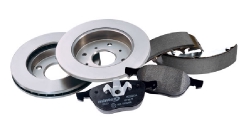Our Solution to your warning 
Brake Pads
Brake pads form a vital part of the disc brake system. The friction material is applied onto the brake disc surface by the caliper pistons to generate the friction to stop the wheels turning. Brake pads are governed by legislation commonly known as Regulation 90. Grinding, squeaking or squealing breaks are a sign that your brakes are not working efficiently. The brake pads are a vital component of your braking system, gripping the brake disc and slowing the car through friction. If your pads are worn, they need to be replaced for your own safety. At J&S we have an extensive range of brake pads and brake sensors for any car.
Brake Discs
A major component of your car's braking system, the brake disc sits on the wheel hub and slows the vehicle down when the brakes are applied through the use of friction. Your vehicle's brake pads 'grab' onto either side of the brake discs through the application of a hydraulic piston. This reduces the speed of the vehicle and allows it to come to a safe stop. Although made of high tensile steel, brake discs for any make and model of car can become worn or pitted over time, and will eventually need replacing. Worn brake discs can produce inefficient braking results, so it is important to check your discs regularly and replace with high quality brake discs only.
Accessories & Fitting Kits, Brake Accessories
The brakes are one of the most important systems in a car, and proper maintenance is essential to keep them in good working order. Brake accessories are also available to give improved performance and reliability. Such brake accessories include brake pads with greater durability and grip, calliper paint for improving the appearance of visible brakes, and brake discs suitable for extreme conditions. Brake fluid is an essential accessory, and must be replaced every couple of years to maintain the effectiveness.
Handbrake Shoes
Handbrake shoes sit inside a rotating metal drum attached to the wheel. When the handbrake lever is pulled up by the driver it pulls cables which in turn force the handbrake shoes against the surface of the brake drum. This provides the friction required to stop the car from moving.
Handbrake shoe for any car rarely wear down as they are generally used to secure the car when it is already stationary. They are however often subject to corrosion, particularly in extreme climates, when contaminated with fluids or worn excessively. They must be replaced to maintain handbrake effectiveness.
ABS Sensors
Each wheel of a vehicle fitted with an Automatic Braking System has an ABS sensor. These sensors pick up signals from the corresponding ABS ring to determine wheel speed, and this information is then sent to the ABS controller which applies corrective pressure to the brakes via the hydraulic unit. ABS ECU which adjusts the braking force applied to each wheel can maximise performance and safety. Malfunctioning of ABS sensors for any car are one of the commonest faults within the ABS system as they are constantly subjected to detrimental factors such as heat, vibration, dirt and moisture due to their location right next to the wheel. Always use good quality ABS sensors.
Brake Pad Wear Sensors
Brake pads are wearing constantly due to the friction and heat produced by the braking process. When the pad wears down to a predetermined level, the brake pad sensor within comes into contact with the metal brake disc and creates an electrical circuit. This in turn illuminates a warning light on the dash board which informs the driver that the brakes need replacing. Correctly functioning brake pad sensors for every make and model of car are vital, as without them it may not be readily apparent that the brakes need replacing. This is as important for road safety as it is for NCT purposes.